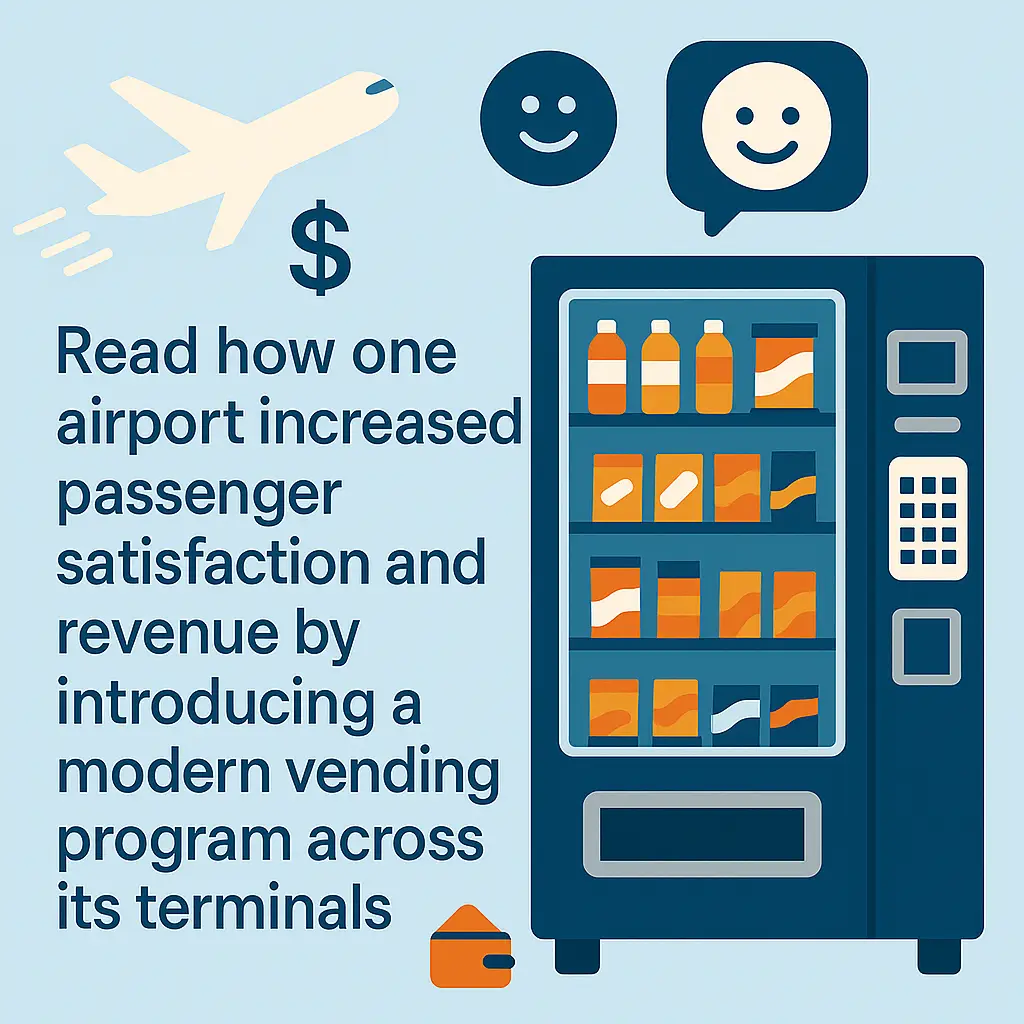Case Study: Airport Vending Success Story
Read how one airport increased passenger satisfaction and revenue by introducing a modern vending program across its terminals.
Back to Vending for Airports ResourcesRead how one airport increased passenger satisfaction and revenue by introducing a modern vending program across its terminals.
Back to Vending for Airports ResourcesThey improve passenger experiences through 24/7 access, reduce congestion at concession stands, and support revenue growth.
![]() Modern vending improves traveler convenience during off-peak hours.
Modern vending improves traveler convenience during off-peak hours.
![]() Quick purchases help reduce lines at busy concession areas.
Quick purchases help reduce lines at busy concession areas.
![]() Smart payment systems enhance speed and passenger satisfaction.
Smart payment systems enhance speed and passenger satisfaction.

Airports face unique challenges when it comes to providing consistent food and beverage options for passengers. Concession stands often close at night, leaving travelers with few choices during late flights or layovers. By strategically implementing modern vending programs, airports can offer 24/7 access to snacks, drinks, and travel essentials without relying solely on traditional concessions.
These programs allow passengers to quickly purchase what they need, reducing the stress of finding open concessions during off-peak hours. This improvement in access plays a direct role in improving overall passenger satisfaction scores and can increase spending per traveler.
One of the most common pain points in busy terminals is long lines at food courts and concession areas. Vending stations placed in strategic high-traffic zones help disperse crowds and reduce wait times. This not only improves passenger flow but also alleviates pressure on existing concessions during peak travel periods.
Many airports are exploring contract structures and permit processes to support this expansion efficiently. With proper planning, vending can complement existing food service models rather than compete with them.
Travelers increasingly expect access to healthier and more diverse products while on the go. Modern machines can be stocked with energy drinks, bottled water, protein snacks, and travel accessories. This variety appeals to both business and leisure travelers, enhancing the overall perception of airport amenities.
For airports considering broader product selections, reviewing healthy vending strategies can offer valuable insights that apply to transportation hubs as well.
Modern vending technology allows airports to easily monitor inventory, accept contactless payments, and minimize downtime. This ensures travelers consistently find stocked and functional machines throughout the terminals. It also simplifies operational oversight, making vending a low-maintenance but high-impact amenity for facilities teams.
Airports exploring modernization may also benefit from learning how micro-market solutions have transformed other sectors with similar logistical challenges. Combining data insights with strategic placements leads to measurable operational gains.
Modern vending is more than a convenience—it’s a strategic way to improve passenger satisfaction, increase non-aeronautical revenue, and keep amenities running smoothly around the clock.
If you're exploring vending options for your business, Vending Exchange can help simplify the process. Delivery, Installation and Equipment is provided at no cost to you - vendors provide the machines, keep them stocked, and handle all servicing. Whether you need a provider or full-service management, just fill out the form on this page to get started.
They provide fast, reliable access to food and drinks at any time.
Bottled beverages, healthy snacks, travel essentials, and energy products sell best.
By adding alternative purchasing options in high-traffic terminal areas.
Yes, they offer 24/7 service when traditional concessions are closed.
Yes, most use contactless payment and smart technology for quick transactions.
They focus on underserved areas and high passenger traffic zones.
Yes, especially in spaces that were previously underutilized.
They reduce strain on concessions, ease congestion, and improve efficiency.
Modern programs can often be fully set up within a week.
Using telemetry systems and scheduled servicing keeps machines reliable and full.